AUX MERCEDES-BENZ SPRINTER 2014 MY14 Operator’s Manual
[x] Cancel search | Manufacturer: MERCEDES-BENZ, Model Year: 2014, Model line: SPRINTER, Model: MERCEDES-BENZ SPRINTER 2014Pages: 338, PDF Size: 6.78 MB
Page 7 of 338
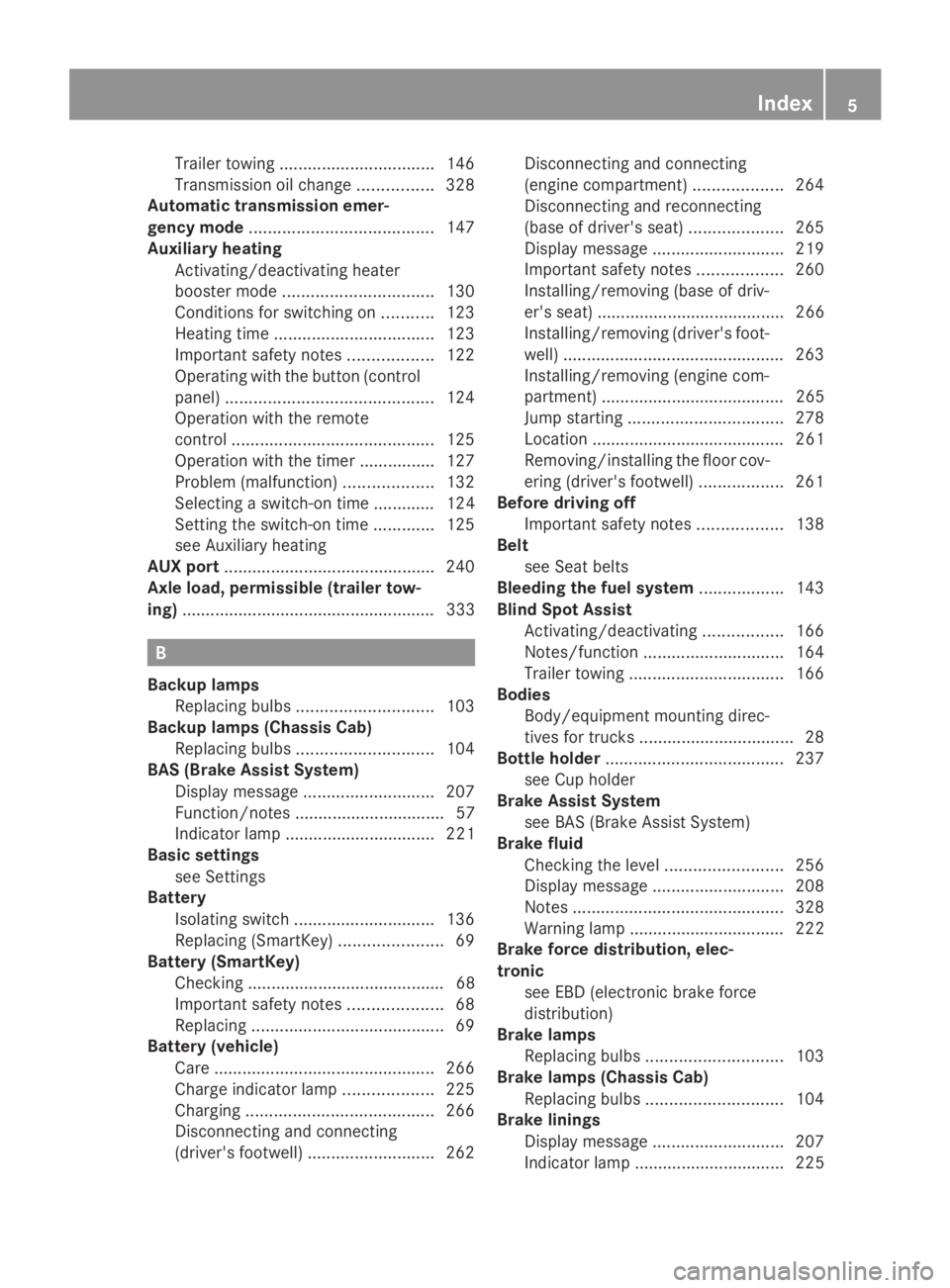
Trailer towing
................................. 146
Transmission oil change ................328
Automatic transmission emer-
gency mode ....................................... 147
Auxiliary heating Activating/deactivating heater
booster mode ................................ 130
Conditions for switching on ...........123
Heating time .................................. 123
Important safety notes ..................122
Operating with the button (control
panel) ............................................ 124
Operation with the remote
control ........................................... 125
Operation with the timer ................127
Problem (malfunction) ...................132
Selecting a switch-on time ............. 124
Setting the switch-on time .............125
see Auxiliary heating
AUX port ............................................ .240
Axle load, permissible (trailer tow-
ing) ...................................................... 333 B
Backup lamps Replacing bulbs ............................. 103
Backup lamps (Chassis Cab)
Replacing bulbs ............................. 104
BAS (Brake Assist System)
Display message ............................ 207
Function/notes ................................ 57
Indicator lamp ................................ 221
Basic settings
see Settings
Battery
Isolating switch .............................. 136
Replacing (SmartKey) ......................69
Battery (SmartKey)
Checking .......................................... 68
Important safety notes ....................68
Replacing ......................................... 69
Battery (vehicle)
Care ............................................... 266
Charge indicator lamp ...................225
Charging ........................................ 266
Disconnecting and connecting
(driver's footwell) ........................... 262Disconnecting and connecting
(engine compartment)
...................264
Disconnecting and reconnecting
(base of driver's seat) ....................265
Display message ............................ 219
Important safety notes ..................260
Installing/removing (base of driv-
er's seat) ........................................ 266
Installing/removing (driver's foot-
well) ............................................... 263
Installing/removing (engine com-
partment) ....................................... 265
Jump starting ................................. 278
Location ......................................... 261
Removing/installing the floor cov-
ering (driver's footwell) ..................261
Before driving off
Important safety notes ..................138
Belt
see Seat belts
Bleeding the fuel system ..................143
Blind Spot Assist Activating/deactivating .................166
Notes/function .............................. 164
Trailer towing ................................. 166
Bodies
Body/equipment mounting direc-
tives for trucks ................................. 28
Bottle holder ...................................... 237
see Cup holder
Brake Assist System
see BAS (Brake Assist System)
Brake fluid
Checking the level .........................256
Display message ............................ 208
Notes ............................................. 328
Warning lamp ................................. 222
Brake force distribution, elec-
tronic
see EBD (electronic brake force
distribution)
Brake lamps
Replacing bulbs ............................. 103
Brake lamps (Chassis Cab)
Replacing bulbs ............................. 104
Brake linings
Display message ............................ 207
Indicator lamp ................................ 225 Index
5
Page 9 of 338
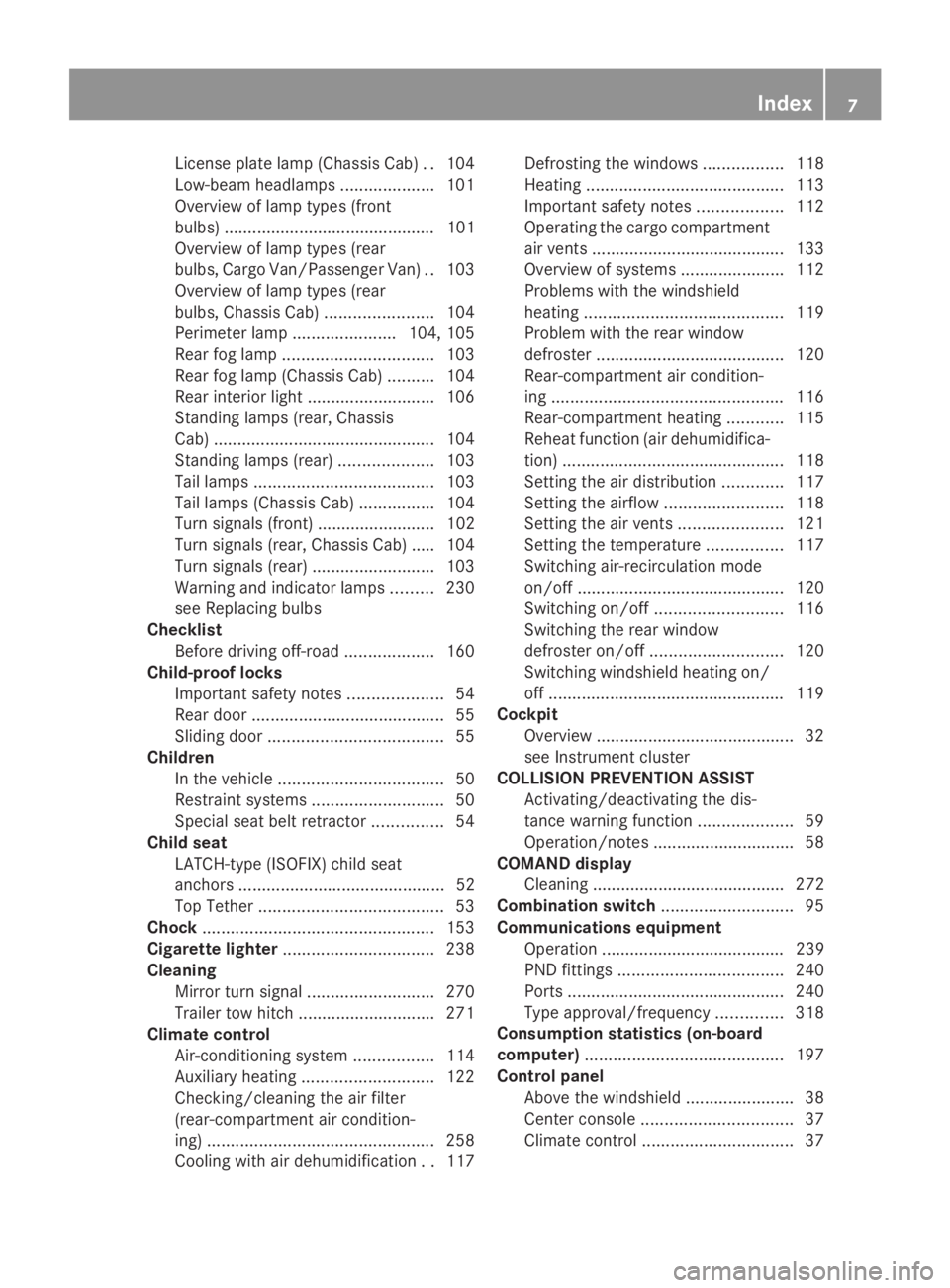
License plate lamp (Chassis Cab).
.104
Low-beam headlamps ....................101
Overview of lamp types (front
bulbs) ............................................. 101
Overview of lamp types (rear
bulbs, Cargo Van/Passenger Van) ..103
Overview of lamp types (rear
bulbs, Chassis Cab) .......................104
Perimeter lamp ......................104, 105
Rear fog lamp ................................ 103
Rear fog lamp (Chassis Cab) ..........104
Rear interior light ........................... 106
Standing lamps (rear, Chassis
Cab) ............................................... 104
Standing lamps (rear) ....................103
Tail lamps ...................................... 103
Tail lamps (Chassis Cab) ................104
Turn signals (front) ......................... 102
Turn signals (rear, Chassis Cab) ..... 104
Turn signals (rear) ..........................103
Warning and indicator lamps .........230
see Replacing bulbs
Checklist
Before driving off-road ...................160
Child-proof locks
Important safety notes ....................54
Rear door ......................................... 55
Sliding door ..................................... 55
Children
In the vehicle ................................... 50
Restraint systems ............................ 50
Special seat belt retractor ...............54
Child seat
LATCH-type (ISOFIX) child seat
anchors ............................................ 52
Top Tether ....................................... 53
Chock ................................................. 153
Cigarette lighter ................................ 238
Cleaning Mirror turn signal ........................... 270
Trailer tow hitch ............................. 271
Climate control
Air-conditioning system .................114
Auxiliary heating ............................ 122
Checking/cleaning the air filter
(rear-compartment air condition-
ing) ................................................ 258
Cooling with air dehumidification ..117 Defrosting the windows
.................118
Heating .......................................... 113
Important safety notes ..................112
Operating the cargo compartment
air vents ......................................... 133
Overview of systems ......................112
Problems with the windshield
heating .......................................... 119
Problem with the rear window
defroster ........................................ 120
Rear-compartment air condition-
ing ................................................. 116
Rear-compartment heating ............115
Reheat function (air dehumidifica-
tion) ............................................... 118
Setting the air distribution .............117
Setting the airflow .........................118
Setting the air vents ......................121
Setting the temperature ................117
Switching air-recirculation mode
on/off ............................................ 120
Switching on/off ........................... 116
Switching the rear window
defroster on/off ............................ 120
Switching windshield heating on/
off .................................................. 119
Cockpit
Overview .......................................... 32
see Instrument cluster
COLLISION PREVENTION ASSIST
Activating/deactivating the dis-
tance warning function ....................59
Operation/notes .............................. 58
COMAND display
Cleaning ......................................... 272
Combination switch ............................95
Communications equipment Operation ....................................... 239
PND fittings ................................... 240
Ports .............................................. 240
Type approval/frequency ..............318
Consumption statistics (on-board
computer) .......................................... 197
Control panel Above the windshield .......................38
Center console ................................ 37
Climate control ................................ 37 Index
7
Page 18 of 338
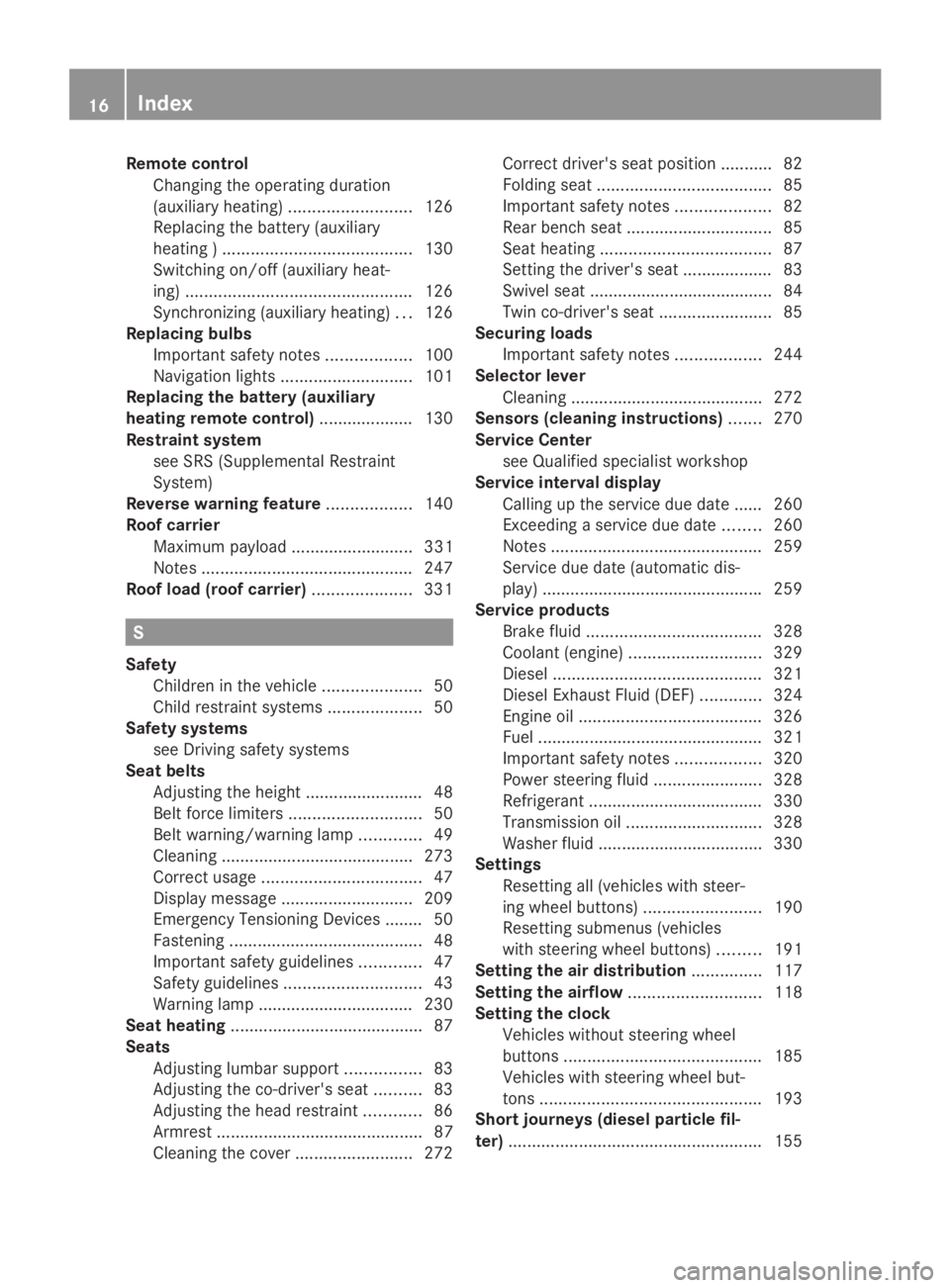
Remote control
Changing the operating duration
(auxiliary heating) .......................... 126
Replacing the battery (auxiliary
heating ) ........................................ 130
Switching on/off (auxiliary heat-
ing) ................................................ 126
Synchronizing (auxiliary heating) ...126
Replacing bulbs
Important safety notes ..................100
Navigation lights ............................ 101
Replacing the battery (auxiliary
heating remote control) .................... 130
Restraint system see SRS (Supplemental Restraint
System)
Reverse warning feature ..................140
Roof carrier Maximum payloa d.......................... 331
Notes ............................................. 247
Roof load (roof carrier) .....................331 S
Safety Children in the vehicle .....................50
Child restraint systems ....................50
Safety systems
see Driving safety systems
Seat belts
Adjusting the height ......................... 48
Belt force limiters ............................ 50
Belt warning/warning lamp .............49
Cleaning ......................................... 273
Correct usage .................................. 47
Display message ............................ 209
Emergency Tensioning Devices ....... .50
Fastening ......................................... 48
Important safety guidelines .............47
Safety guidelines ............................. 43
Warning lamp ................................. 230
Seat heating ........................................ .87
Seats Adjusting lumbar support ................83
Adjusting the co-driver's sea t.......... 83
Adjusting the head restraint ............86
Armrest ............................................ 87
Cleaning the cover .........................272Correct driver's seat position ........... 82
Folding seat
..................................... 85
Important safety notes ....................82
Rear bench seat ............................... 85
Seat heating .................................... 87
Setting the driver's seat ................... 83
Swivel seat ....................................... 84
Twin co-driver's seat ........................85
Securing loads
Important safety notes ..................244
Selector lever
Cleaning ......................................... 272
Sensors (cleaning instructions) .......270
Service Center see Qualified specialist workshop
Service interval display
Calling up the service due date ...... 260
Exceeding a service due date ........260
Notes ............................................. 259
Service due date (automatic dis-
play) .............................................. .259
Service products
Brake fluid ..................................... 328
Coolant (engine) ............................ 329
Diesel ............................................ 321
Diesel Exhaust Fluid (DEF) .............324
Engine oil ....................................... 326
Fuel ................................................ 321
Important safety notes ..................320
Power steering fluid .......................328
Refrigerant ..................................... 330
Transmission oil ............................. 328
Washer fluid .................................. .330
Settings
Resetting all (vehicles with steer-
ing wheel buttons) .........................190
Resetting submenus (vehicles
with steering wheel buttons) .........191
Setting the air distribution ...............117
Setting the airflow ............................118
Setting the clock Vehicles without steering wheel
buttons .......................................... 185
Vehicles with steering wheel but-
tons ............................................... 193
Short journeys (diesel particle fil-
ter) ...................................................... 15516
Index
Page 20 of 338
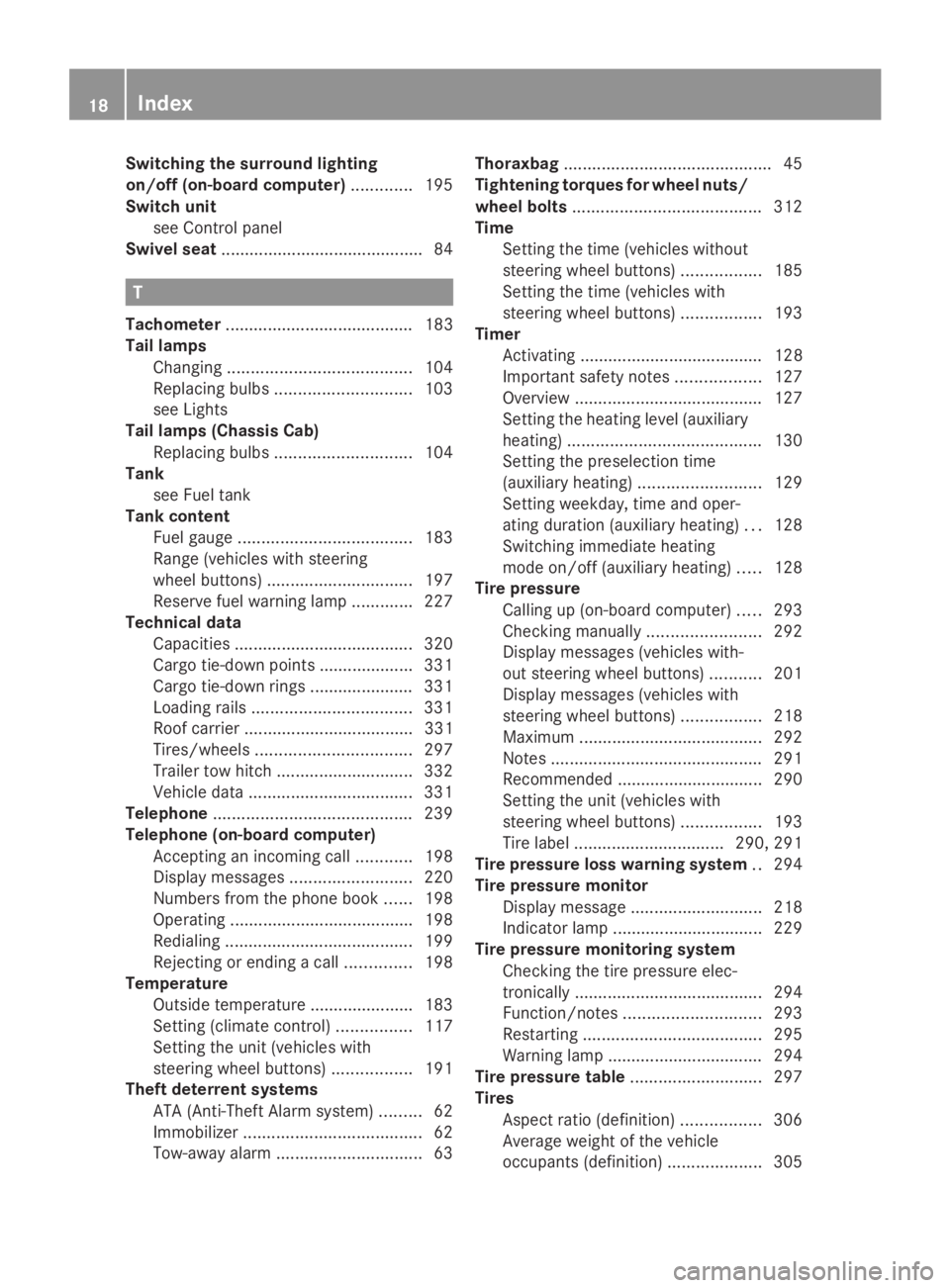
Switching the surround lighting
on/off (on-board computer)
.............195
Switch unit see Control panel
Swivel seat .......................................... .84T
Tachometer ........................................ 183
Tail lamps Changing ....................................... 104
Replacing bulbs ............................. 103
see Lights
Tail lamps (Chassis Cab)
Replacing bulbs ............................. 104
Tank
see Fuel tank
Tank content
Fuel gauge ..................................... 183
Range (vehicles with steering
wheel buttons) ............................... 197
Reserve fuel warning lamp .............227
Technical data
Capacities ...................................... 320
Cargo tie-down points .................... 331
Cargo tie-down rings ..................... .331
Loading rails .................................. 331
Roof carrier .................................... 331
Tires/wheels ................................. 297
Trailer tow hitch ............................. 332
Vehicle data ................................... 331
Telephone .......................................... 239
Telephone (on-board computer) Accepting an incoming call ............198
Display messages ..........................220
Numbers from the phone book ......198
Operating ...................................... .198
Redialing ........................................ 199
Rejecting or ending a call ..............198
Temperature
Outside temperature ..................... .183
Setting (climate control) ................117
Setting the unit (vehicles with
steering wheel buttons) .................191
Theft deterrent systems
ATA (Anti-Theft Alarm system) .........62
Immobilizer ...................................... 62
Tow-away alarm ............................... 63Thoraxbag
............................................ 45
Tightening torques for wheel nuts/
wheel bolts ........................................ 312
Time Setting the time (vehicles without
steering wheel buttons) .................185
Setting the time (vehicles with
steering wheel buttons) .................193
Timer
Activating ....................................... 128
Important safety notes ..................127
Overview ........................................ 127
Setting the heating level (auxiliary
heating) ......................................... 130
Setting the preselection time
(auxiliary heating) .......................... 129
Setting weekday, time and oper-
ating duration (auxiliary heating) ...128
Switching immediate heating
mode on/off (auxiliary heating) .....128
Tire pressure
Calling up (on-board computer) .....293
Checking manually ........................292
Display messages (vehicles with-
out steering wheel buttons) ...........201
Display messages (vehicles with
steering wheel buttons) .................218
Maximum ....................................... 292
Notes ............................................. 291
Recommended ............................... 290
Setting the unit (vehicles with
steering wheel buttons) .................193
Tire label ................................ 290, 291
Tire pressure loss warning system ..294
Tire pressure monitor Display message ............................ 218
Indicator lamp ................................ 229
Tire pressure monitoring system
Checking the tire pressure elec-
tronically ........................................ 294
Function/notes ............................. 293
Restarting ...................................... 295
Warning lamp ................................. 294
Tire pressure table ............................297
Tires Aspect ratio (definition) .................306
Average weight of the vehicle
occupants (definition) ....................30518
Index
Page 34 of 338
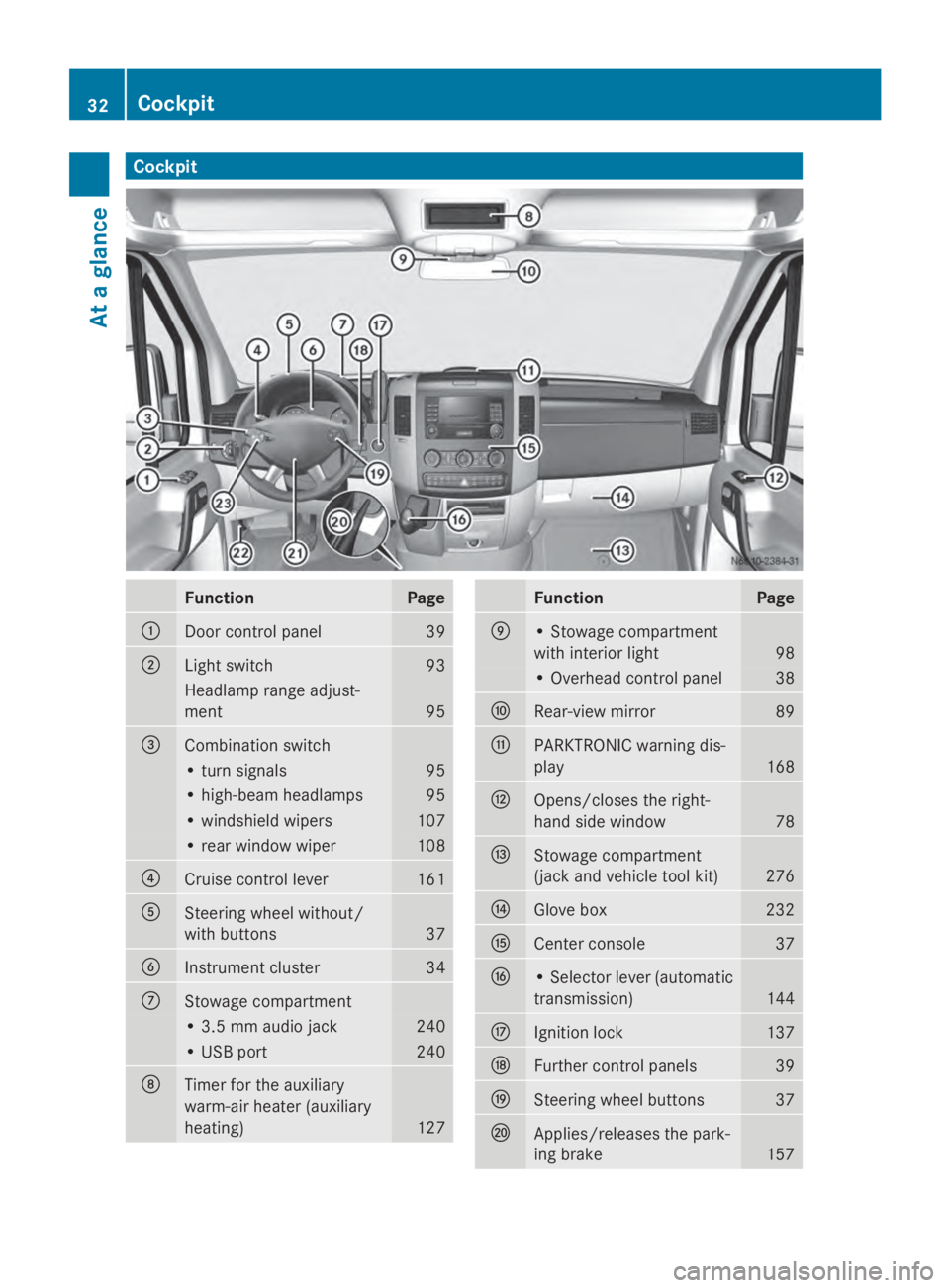
Cockpit
Function Page
0043
Door control panel 39
0044
Light switch 93
Headlamp range adjust-
ment 95
0087
Combination switch
• turn signals 95
• high-beam headlamps 95
• windshield wipers 107
• rear window wiper 108
0085
Cruise control lever 161
0083
Steering wheel without/
with buttons
37
0084
Instrument cluster 34
006B
Stowage compartment
• 3.5 mm audio jack 240
• USB port 240
006C
Timer for the auxiliary
warm-air heater (auxiliary
heating)
127 Function Page
006D
• Stowage compartment
with interior light
98
• Overhead control panel 38
006E
Rear-view mirror 89
006F
PARKTRONIC warning dis-
play
168
0070
Opens/closes the right-
hand side window
78
0071
Stowage compartment
(jack and vehicle tool kit)
276
0072
Glove box 232
0073
Center console 37
0074
• Selector lever (automatic
transmission)
144
0075
Ignition lock 137
0076
Further control panels 39
0077
Steering wheel buttons 37
0078
Applies/releases the park-
ing brake
15732
CockpitAt a glance
Page 41 of 338
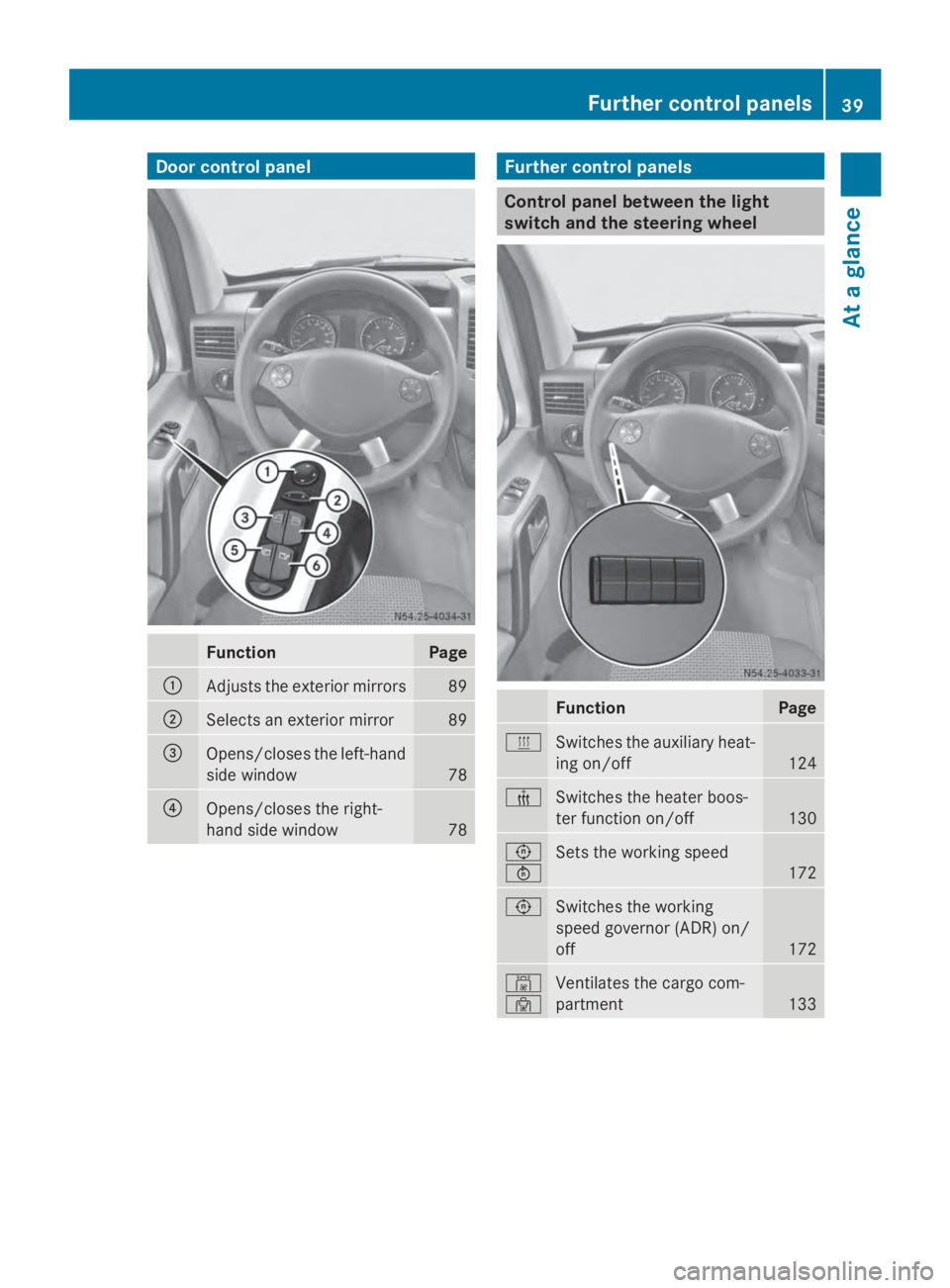
Door control panel
Function Page
0043
Adjusts the exterior mirrors 89
0044
Selects an exterior mirror 89
0087
Opens/closes the left-hand
side window
78
0085
Opens/closes the right-
hand side window 78 Further control panels
Control panel between the light
switch and the steering wheel
Function Page
0084
Switches the auxiliary heat-
ing on/off
124
00AB
Switches the heater boos-
ter function on/off
130
0091
0092
Sets the working speed
172
0091
Switches the working
speed governor (ADR) on/
off
172
00A8
00A7
Ventilates the cargo com-
partment
133Further cont
rol panels
39At a glance
Page 65 of 338
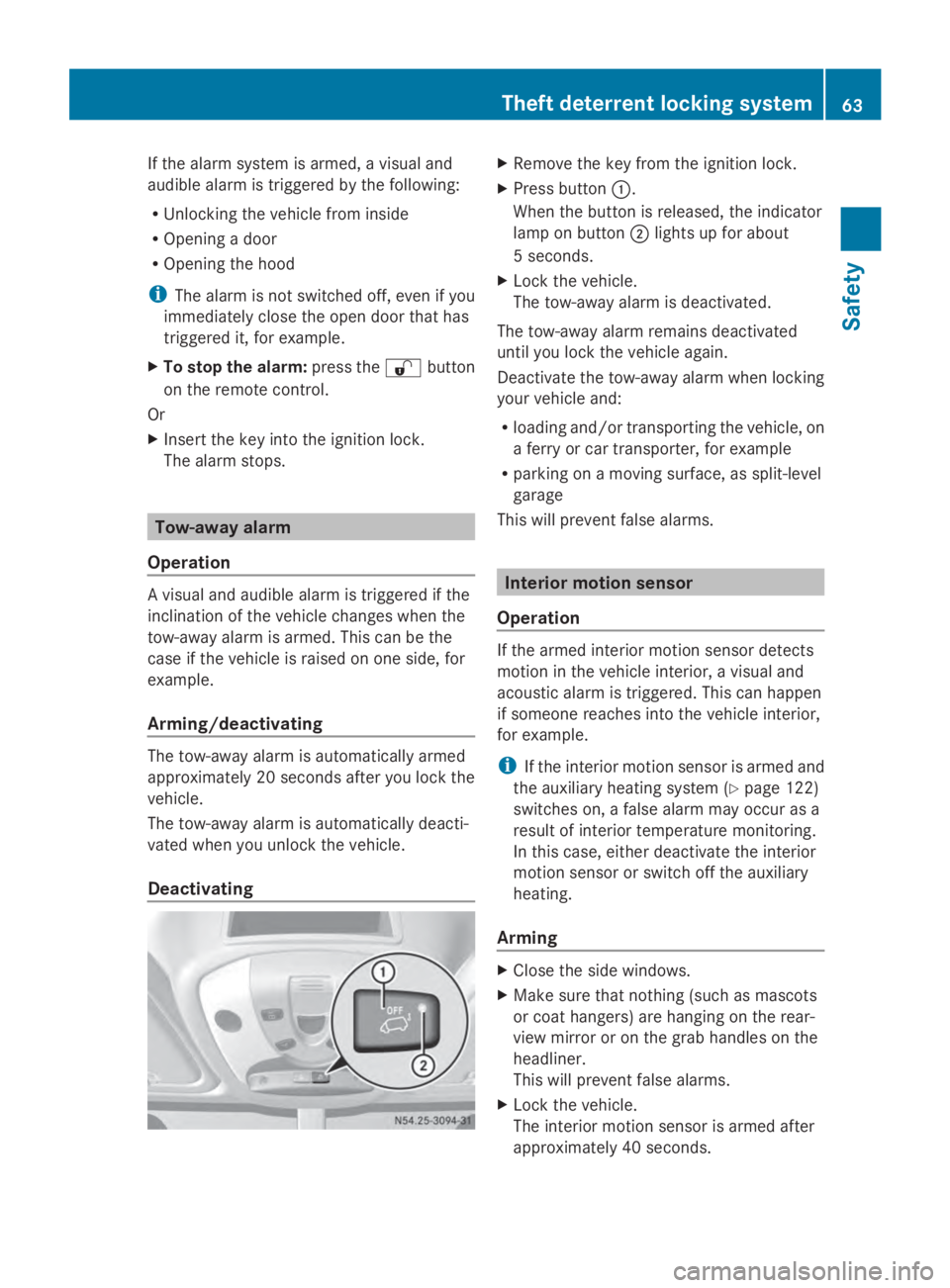
If the alarm system is armed, a visual and
audible alarm is triggered by the following:
R Unlocking the vehicle from inside
R Opening a door
R Opening the hood
i The alarm is not switched off, even if you
immediately close the open door that has
triggered it, for example.
X To stop the alarm: press the0036button
on the remote control.
Or
X Insert the key into the ignition lock.
The alarm stops. Tow-away alarm
Operation A visual and audible alarm is triggered if the
inclination of the vehicle changes when the
tow-away alarm is armed. This can be the
case if the vehicle is raised on one side, for
example.
Arming/deactivating The tow-away alarm is automatically armed
approximately 20 seconds after you lock the
vehicle.
The tow-away alarm is automatically deacti-
vated when you unlock the vehicle.
Deactivating X
Remove the key from the ignition lock.
X Press button 0043.
When the button is released, the indicator
lamp on button 0044lights up for about
5 seconds.
X Lock the vehicle.
The tow-away alarm is deactivated.
The tow-away alarm remains deactivated
until you lock the vehicle again.
Deactivate the tow-away alarm when locking
your vehicle and:
R loading and/or transporting the vehicle, on
a ferry or car transporter, for example
R parking on a moving surface, as split-level
garage
This will prevent false alarms. Interior motion sensor
Operation If the armed interior motion sensor detects
motion in the vehicle interior, a visual and
acoustic alarm is triggered. This can happen
if someone reaches into the vehicle interior,
for example.
i
If the interior motion sensor is armed and
the auxiliary heating system (Y page 122)
switches on, a false alarm may occur as a
result of interior temperature monitoring.
In this case, either deactivate the interior
motion sensor or switch off the auxiliary
heating.
Arming X
Close the side windows.
X Make sure that nothing (such as mascots
or coat hangers) are hanging on the rear-
view mirror or on the grab handles on the
headliner.
This will prevent false alarms.
X Lock the vehicle.
The interior motion sensor is armed after
approximately 40 seconds. Theft deterrent locking system
63Safety Z
Page 113 of 338
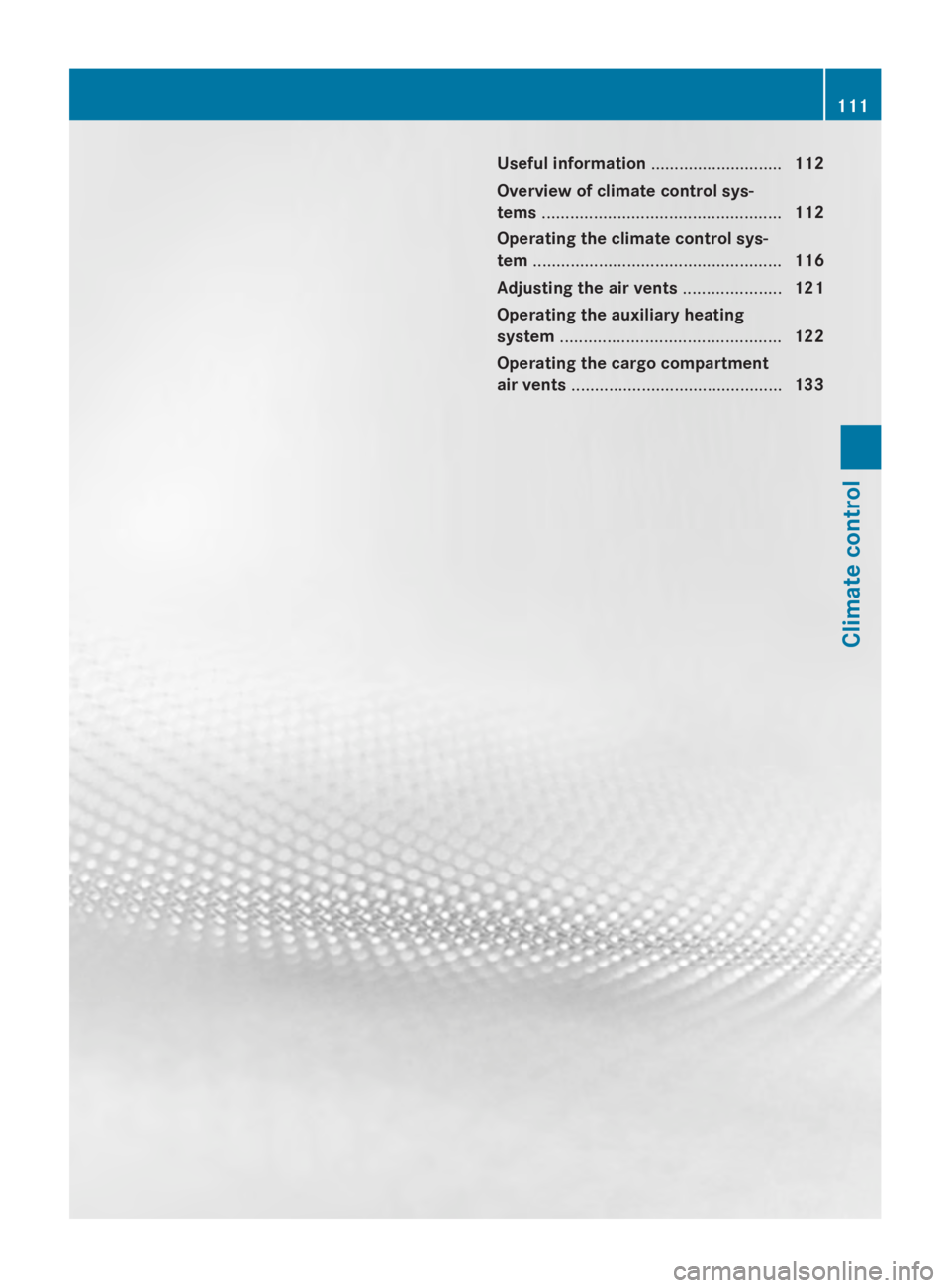
Useful information
............................112
Overview of climate control sys-
tems ................................................... 112
Operating the climate control sys-
tem ..................................................... 116
Adjusting the air vents .....................121
Operating the auxiliary heating
system ............................................... 122
Operating the cargo compartment
air vents ............................................. 133 111Climate control
Page 124 of 338
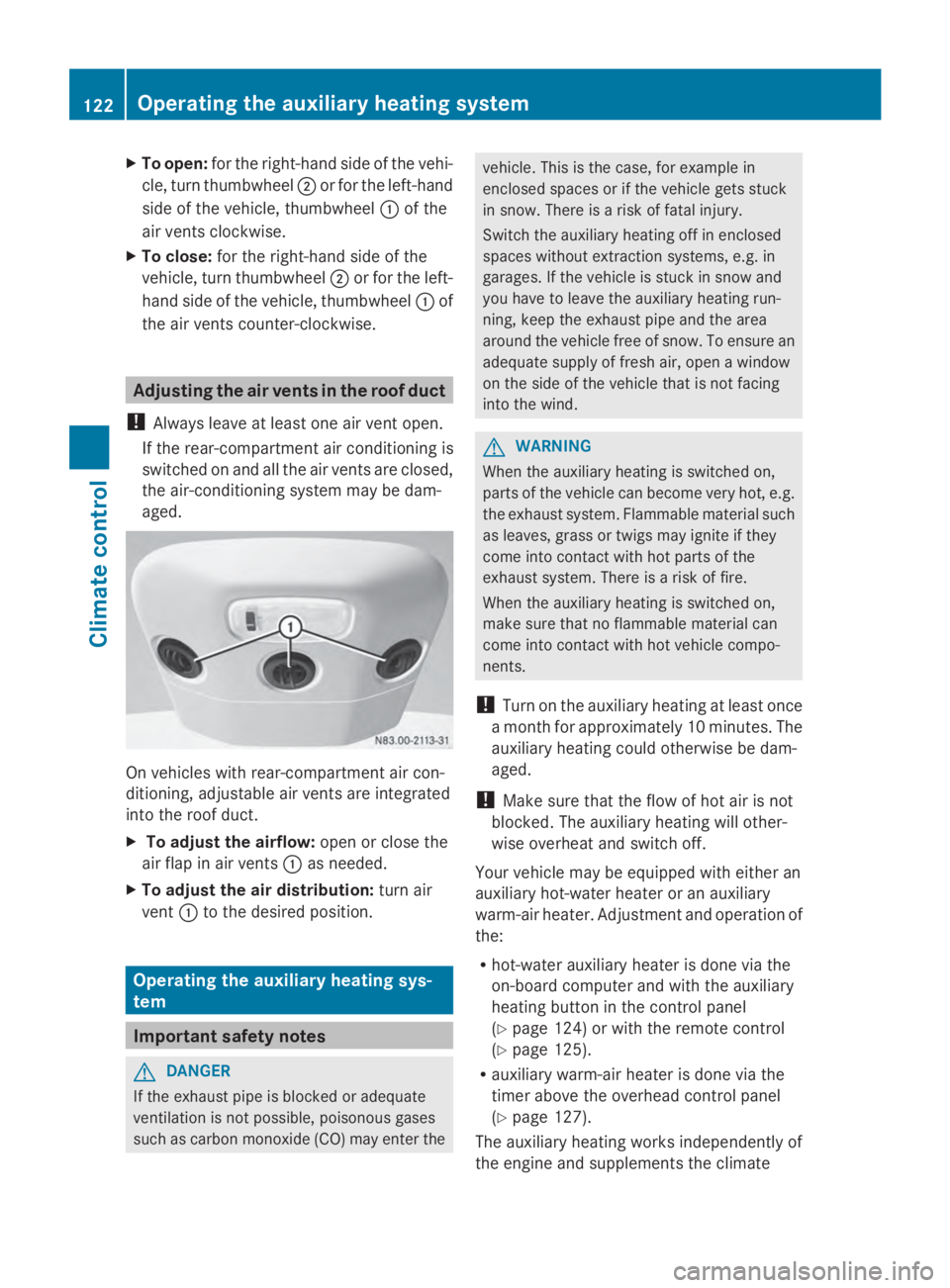
X
To open: for the right-hand side of the vehi-
cle, turn thumbwheel 0044or for the left-hand
side of the vehicle, thumbwheel 0043of the
air vents clockwise.
X To close: for the right-hand side of the
vehicle, turn thumbwheel 0044or for the left-
hand side of the vehicle, thumbwheel 0043of
the air vents counter-clockwise. Adjusting the air vents in the roof duct
! Always leave at least one air vent open.
If the rear-compartment air conditioning is
switched on and all the air vents are closed,
the air-conditioning system may be dam-
aged. On vehicles with rear-compartment air con-
ditioning, adjustable air vents are integrated
into the roof duct.
X To adjust the airflow: open or close the
air flap in air vents 0043as needed.
X To adjust the air distribution: turn air
vent 0043to the desired position. Operating the auxiliary heating sys-
tem Important safety notes
G
DANGER
If the exhaust pipe is blocked or adequate
ventilation is not possible, poisonous gases
such as carbon monoxide (CO) may enter the vehicle. This is the case, for example in
enclosed spaces or if the vehicle gets stuck
in snow. There is a risk of fatal injury.
Switch the auxiliary heating off in enclosed
spaces without extraction systems, e.g. in
garages. If the vehicle is stuck in snow and
you have to leave the auxiliary heating run-
ning, keep the exhaust pipe and the area
around the vehicle free of snow. To ensure an
adequate supply of fresh air, open a window
on the side of the vehicle that is not facing
into the wind. G
WARNING
When the auxiliary heating is switched on,
parts of the vehicle can become very hot, e.g.
the exhaust system. Flammable material such
as leaves, grass or twigs may ignite if they
come into contact with hot parts of the
exhaust system. There is a risk of fire.
When the auxiliary heating is switched on,
make sure that no flammable material can
come into contact with hot vehicle compo-
nents.
! Turn on the auxiliary heating at least once
a month for approximately 10 minutes. The
auxiliary heating could otherwise be dam-
aged.
! Make sure that the flow of hot air is not
blocked. The auxiliary heating will other-
wise overheat and switch off.
Your vehicle may be equipped with either an
auxiliary hot-water heater or an auxiliary
warm-air heater. Adjustment and operation of
the:
R hot-water auxiliary heater is done via the
on-board computer and with the auxiliary
heating button in the control panel
(Y page 124) or with the remote control
(Y page 125).
R auxiliary warm-air heater is done via the
timer above the overhead control panel
(Y page 127).
The auxiliary heating works independently of
the engine and supplements the climate 122
Operating the auxiliary heating systemClimate control
Page 125 of 338
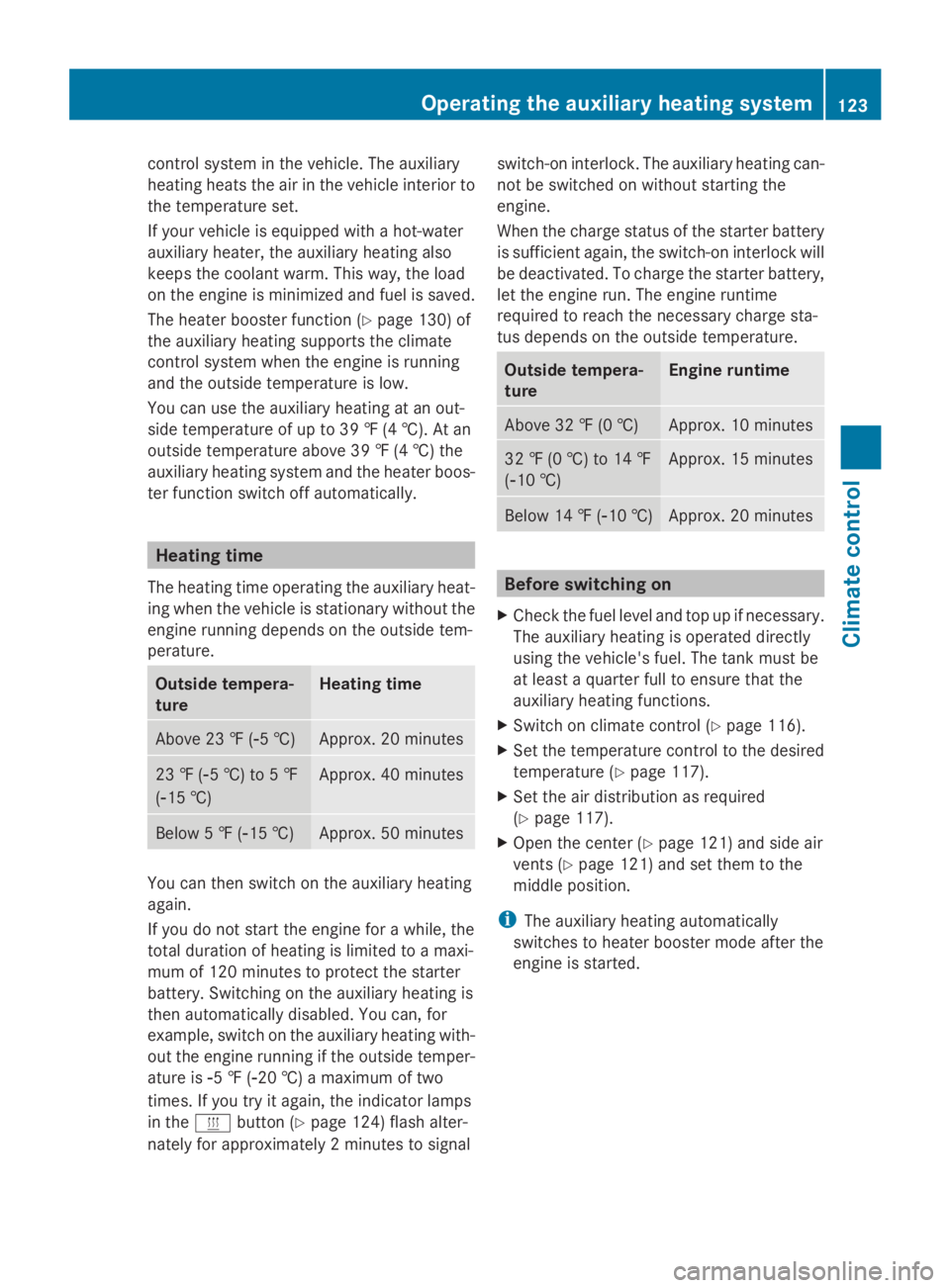
control system in the vehicle. The auxiliary
heating heats the air in the vehicle interior to
the temperature set.
If your vehicle is equipped with a hot-water
auxiliary heater, the auxiliary heating also
keeps the coolant warm. This way, the load
on the engine is minimized and fuel is saved.
The heater booster function (Y page 130) of
the auxiliary heating supports the climate
control system when the engine is running
and the outside temperature is low.
You can use the auxiliary heating at an out-
side temperature of up to 39 ‡ (4 †). At an
outside temperature above 39 ‡ (4 †) the
auxiliary heating system and the heater boos-
ter function switch off automatically. Heating time
The heating time operating the auxiliary heat-
ing when the vehicle is stationary without the
engine running depends on the outside tem-
perature. Outside tempera-
ture Heating time
Above 23 ‡ (
00F85 †) Approx. 20 minutes
23 ‡ (
00F85 †) to 5 ‡
(00F815 †) Approx. 40 minutes
Below 5 ‡ (00F815 †) Approx. 50 minutes
You can then switch on the auxiliary heating
again.
If you do not start the engine for a while, the
total duration of heating is limited to a maxi-
mum of 120 minutes to protect the starter
battery. Switching on the auxiliary heating is
then automatically disabled. You can, for
example, switch on the auxiliary heating with-
out the engine running if the outside temper-
ature is
00F85 ‡ (00F820 †) a maximum of two
times. If you try it again, the indicator lamps
in the 0084button (Y page 124) flash alter-
nately for approximately 2 minutes to signal switch-on interlock. The auxiliary heating can-
not be switched on without starting the
engine.
When the charge status of the starter battery
is sufficient again, the switch-on interlock will
be deactivated. To charge the starter battery,
let the engine run. The engine runtime
required to reach the necessary charge sta-
tus depends on the outside temperature.
Outside tempera-
ture Engine runtime
Above 32 ‡ (0 †) Approx. 10 minutes
32 ‡ (0 †) to 14 ‡
(00F810 †) Approx. 15 minutes
Below 14 ‡ (
00F810 †) Approx. 20 minutes
Before switching on
X Check the fuel level and top up if necessary.
The auxiliary heating is operated directly
using the vehicle's fuel. The tank must be
at least a quarter full to ensure that the
auxiliary heating functions.
X Switch on climate control (Y page 116).
X Set the temperature control to the desired
temperature (Y page 117).
X Set the air distribution as required
(Y page 117).
X Open the center (Y page 121) and side air
vents ( Ypage 121) and set them to the
middle position.
i The auxiliary heating automatically
switches to heater booster mode after the
engine is started. Operating the auxiliary heating system
123Climate control Z